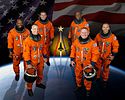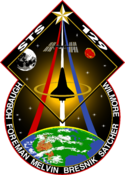STS-129
 | |
| Dane misji | |
| Indeks COSPAR | 2009-062A |
|---|---|
| Zaangażowani | |
| Oznaczenie kodowe | STS-129 |
| Pojazd | |
| Wahadłowiec | Atlantis |
| Załoga | |
 Od lewej w dolnym rzędzie: dowódca Charlie Hobaugh i pilot Barry Wilmore, z tyłu od lewej stoją specjaliści misji: Leland Melvin, Mike Foreman, Robert Satcher i Randolph Bresnik. | |
| Dowódca | Charles Hobaugh |
| Start | |
| Miejsce startu | Stany Zjednoczone, KSC, LC39-A |
| Początek misji | 16 listopada 2009 19:28:10 UTC[1] |
| Orbita okołoziemska | |
| Apogeum | 348[2] km |
| Perygeum | 336[2] km |
| Okres orbitalny | 91,4[2] min |
| Inklinacja orbity | 51,6[2]° |
| Lądowanie | |
| Miejsce lądowania | KSC, pas startowy 33[3] |
| Lądowanie | 27 listopada 2009 14:44:23 UTC[4] |
| Czas trwania misji | 10 dni 19 godzin 16 minut i 13 sekund[4] |
| Przebyta odległość | 7 226 177 km (4 490 138 mil)[3] |
| Liczba okrążeń Ziemi | 171[3] |
| Program lotów wahadłowców | |
STS 129 (ang. Space Transportation System) – trzydziesty pierwszy lot w kosmos promu Atlantis i sto dwudziesta dziewiąta misja programu lotów wahadłowców. Głównym celem lotu było dostarczenie na ISS dwóch części modułu ExPRESS Logistics Carrier (ELC-1 i ELC-2).
Misja promu rozpoczęła się 16 listopada 2009 roku. Po blisko 11 dniach lotu, 27 listopada, wahadłowiec wylądował w Centrum Kosmicznym imienia Johna F. Kennedy'ego.
Załoga
- źródło[5]
Skład załogi, która wzięła udział w misji ogłoszono 30 września 2008[6].
- Charles O. Hobaugh (3)* – dowódca, NASA, USA
- Barry E. Wilmore (1) – pilot, NASA, USA
- Michael J. Foreman (2) – specjalista misji, NASA, USA
- Robert L. Satcher, Jr. (1) – specjalista misji, NASA, USA
- Randolf J. Bresnik (1) – specjalista misji, NASA, USA
- Leland D. Melvin (2) – specjalista misji, NASA, USA
Odwieziony na Ziemię członek Ekspedycji 20
- Nicole Stott (1) – specjalista misji, NASA, USA
- *(liczba w nawiasie oznacza liczbę lotów odbytych przez każdego z astronautów)
Dokowanie do ISS
- Połączenie z ISS: 18 listopada 2009, 16:51:19 UTC[1]
- Odłączenie od ISS: 25 listopada, 09:53:08 UTC[1]
- Łączny czas dokowania: 6 dni 17 godzin 1 minuta 49 sekund
Zobacz też
Przypisy
- ↑ a b c STS-129. Loty kosmiczne. [dostęp 2014-06-24].
- ↑ a b c d Mark Wade: STS-129 (ang.). W: Encyclopedia Astronautica [on-line]. [dostęp 2017-07-18].
- ↑ a b c Adam Chen, William Wallack, George Gonzales: Celebrating 30 Years of the Space Shuttle program. NASA, 2012. ISBN 978-0-16-090202-4.
- ↑ a b Spaceflight Now: Relacja z lądowania misji STS-129 (ang.). [zarchiwizowane z tego adresu (2012-12-10)].
- ↑ Robert Godwin: Space Shuttle. Warszawa: Prószyński Media Sp. z o.o., 2011, s. 92, seria: Historia podboju Kosmosu. ISBN 978-83-7648-973-5.
- ↑ Oficjalny komunikat NASA o składzie załogi (ang.)
Linki zewnętrzne
- Wszystko o misji na stronach portalu Kosmonauta.net
- Informacje o misji na stronie NASA (ang.)
- Spaceflight mission report: STS-129 (ang.). Spacefacts.
- STS-129. Loty kosmiczne. [dostęp 2014-06-24].
Media użyte na tej stronie
The flag of Navassa Island is simply the United States flag. It does not have a "local" flag or "unofficial" flag; it is an uninhabited island. The version with a profile view was based on Flags of the World and as a fictional design has no status warranting a place on any Wiki. It was made up by a random person with no connection to the island, it has never flown on the island, and it has never received any sort of recognition or validation by any authority. The person quoted on that page has no authority to bestow a flag, "unofficial" or otherwise, on the island.
Attired in training versions of their shuttle launch and entry suits, these six astronauts take a break from training to pose for the STS-129 crew portrait. Pictured on the front row are astronauts Charlie Hobaugh (left), commander; and Barry Wilmore, pilot. From the left (back row) are astronauts Leland Melvin, Mike Foreman, Robert Satcher and Randy Bresnik, all mission specialists.
CAPE CANAVERAL, Fla. - Like a phoenix rising from the flames, space shuttle Atlantis emerges from the exhaust cloud building on Launch Pad 39A at NASA's Kennedy Space Center in Florida. Liftoff on its STS-129 mission came at 2:28 p.m. EST Nov. 16. Aboard are crew members Commander Charles O. Hobaugh; Pilot Barry E. Wilmore; and Mission Specialists Leland Melvin, Randy Bresnik, Mike Foreman and Robert L. Satcher Jr. On STS-129, the crew will deliver two Express Logistics Carriers to the International Space Station, the largest of the shuttle's cargo carriers, containing 15 spare pieces of equipment including two gyroscopes, two nitrogen tank assemblies, two pump modules, an ammonia tank assembly and a spare latching end effector for the station's robotic arm. Atlantis will return to Earth a station crew member, Nicole Stott, who has spent more than two months aboard the orbiting laboratory. STS-129 is slated to be the final space shuttle Expedition crew rotation flight. For information on the STS-129 mission and crew, visit http://www.nasa.gov/mission_pages/shuttle/shuttlemissions/sts129/index.html.
For STS-129 the sun shines brightly on the International Space Station (ISS) above and the United States below representing the bright future of U.S. human spaceflight. The contiguous U.S., Rocky Mountains, and Great Desert Southwest are clearly visible on the earth below encompassing all the NASA centers and the homes of the many dedicated people that work to make our Space Program possible. The integrated shapes of the patch signifying the two Express Logistics Carriers that will be delivered by STS-129 providing valuable equipment ensuring the longevity of the ISS. The Space Shuttle is vividly silhouetted by the sun highlighting how brightly the Orbiters have performed as a workhorse for the U.S. Space Program over the past 3 decades. The Space Shuttle ascends on the Astronaut symbol portrayed by the Red, White and Blue swoosh bounded by the gold halo. This symbol is worn with pride by this U.S. crew representing their country on STS-129. The names of the crew members are denoted on the outer band of the patch. As STS-129 launches, the Space Shuttle is in its twilight years. This fact is juxtaposed by the 13 stars on the patch which are symbolic of our children who are the future. The Moon and Mars feature predominantly to represent just how close humankind is to reaching further exploration of those heavenly bodies and how the current Space Shuttle and ISS missions are laying the essential ground work for those future endeavors.






